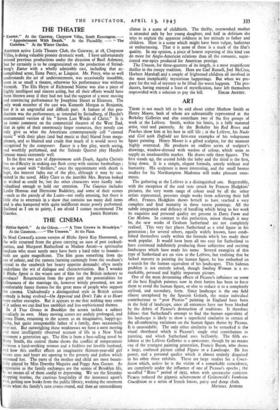ART
THERE is not much left to be said about either Mathew Smith or Henry Moore, both of whom are substantially represented at the Berkeley Galleries and also contribute two of the five groups of work at the Lefevre. Smith, within his limits, is a fully matured artist, vital and painterly. At the Berkeley his Red Roses and Peaches show him at his best in still life ; at the Lefevre, his Nude and Girl with Daffodil are first-rate examples of his voluptuous figure painting. Henry Moore is a gifted sculptor, for the moment highly overrated. He produces an endless series of sculptor's drawings, window-dressed with washes of colour, which seem to supply an inexhaustible market. He draws only three figures. The first stands up, the second holds the baby and the third is the first, lying down. It is a simple, elegant formula, utterly without real humanity. His sculpture is more interesting, and the small bronze studies for his Northampton Madonna will make pleasant orna- ments.
The gathering at the Lefevre is a distinguished one. Regrettably, with the exception of the cool note struck by Frances Hodgkins' pictures, the very warm range of colour used by all the other artists represented, prevents single works from achieving their full effect. Frances Hodgkins shows herself to have reached a very complete and final maturity in these recent paintings. All the subtle integration and delicacy of handling which bring to her work its exquisite and personal quality are present in Dairy Farm and Cut Melons. In contrast to this perfection, minor though it may be, the new works of Graham Sutherland are not completely realised. This very fact places Sutherland as a vital figure in his generation ; for several others, equally widely known, have estab- lished themselves cosily within the formula which has made their work popular. It would have been all too easy for Sutherland to have continued indefinitely producing those subjective and exciting landscapes which have made his name. Several examples of this type of Sutherland are on view at the Lefevre, but realising that he lacked mastery in painting the human figure, he has embarked on a search for the human equivalent of his landscapes. This hideous problem is not entirely solved, though Smiling Woman is a re- markable, personal and highly important picture. One of the most devastating effects of Picasso's influence on some of the best English painters 'now in their forties has been to force them to avoid the human figure, or else to reduce it to a completely stylised, and secondary, form. Since landscape is the one field almost unexplored by the Spanish Goliath, the major individual contributions to " post Picasso" painting in England have been in the field of landscape, since all entrances have not been blocked by the debris of Picasso's destruction of traditions. It therefore follows that Sutherland's attempt to find the-human equivalent of his landscape is likely to show a superficial similarity to certain of the all-embracing variations on the human figure theme by Picasso. It is unavoidable. The only other similarity to be remarked is the visual shorthand which is Picasso's single vital contribution to painting, and which Sutherland uses brilliantly. The fifth ex- hibitor at the Lefevre Galleries is a newcomer, though by no means one of the youngest painting generation, Francis Bacon, who shows a large, confused picture called Figure in a Landscape. He has power, and a personal quality which is almost entirely disguised in his other three exhibits. These are large studies for a Cruci- fixion which, unless he is the victim of a remarkable coincidence, are completely under the influence of one of Picasso's epochs ; the so-called " Bone " period of x932, when with spectacular cynicism Picasso reduced the gigantic achievement of Grunewald's Isenheim Crucifixion to a series of french loaves, putty and damp cloth.
MICHAEL AYRTON


























 Previous page
Previous page